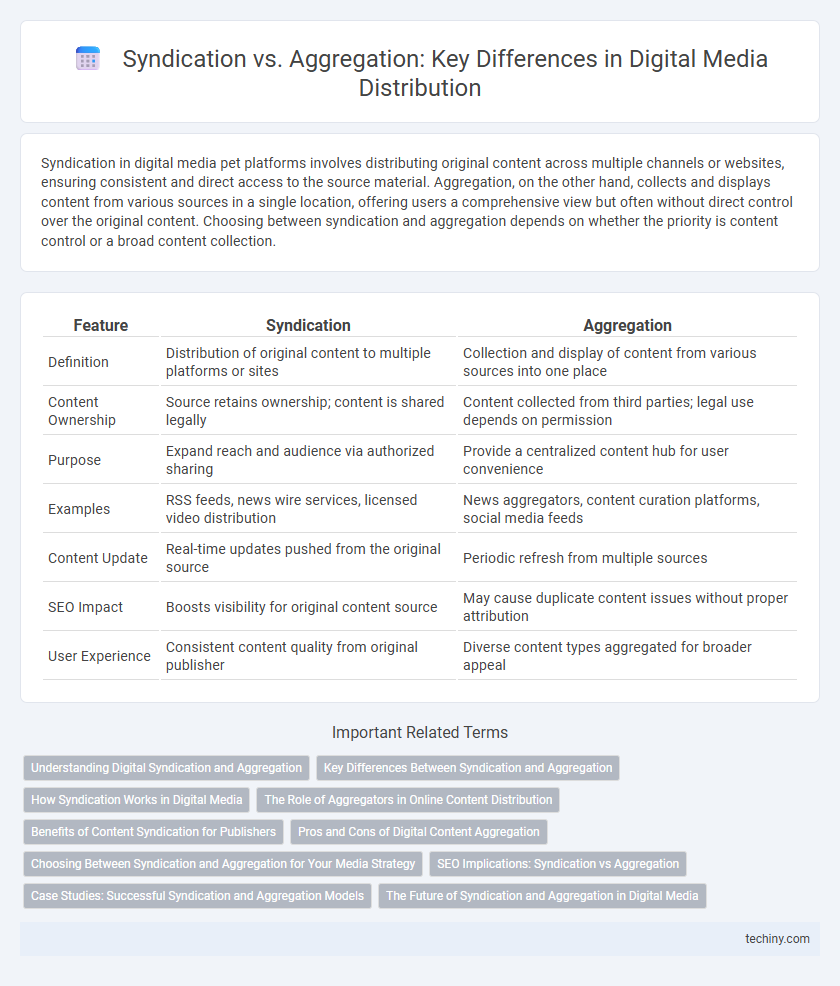Syndication in digital media pet platforms involves distributing original content across multiple channels or websites, ensuring consistent and direct access to the source material. Aggregation, on the other hand, collects and displays content from various sources in a single location, offering users a comprehensive view but often without direct control over the original content. Choosing between syndication and aggregation depends on whether the priority is content control or a broad content collection.
Table of Comparison
| Feature | Syndication | Aggregation |
|---|---|---|
| Definition | Distribution of original content to multiple platforms or sites | Collection and display of content from various sources into one place |
| Content Ownership | Source retains ownership; content is shared legally | Content collected from third parties; legal use depends on permission |
| Purpose | Expand reach and audience via authorized sharing | Provide a centralized content hub for user convenience |
| Examples | RSS feeds, news wire services, licensed video distribution | News aggregators, content curation platforms, social media feeds |
| Content Update | Real-time updates pushed from the original source | Periodic refresh from multiple sources |
| SEO Impact | Boosts visibility for original content source | May cause duplicate content issues without proper attribution |
| User Experience | Consistent content quality from original publisher | Diverse content types aggregated for broader appeal |
Understanding Digital Syndication and Aggregation
Digital syndication involves distributing content directly from the original source to multiple platforms, maintaining ownership and control over the content's presentation and monetization. Aggregation collects and compiles content from various sources into a single platform, offering users a centralized access point but often with limited control over individual content rights. Understanding the distinctions between syndication and aggregation is crucial for digital media strategies, as it impacts content distribution, audience reach, and revenue models.
Key Differences Between Syndication and Aggregation
Syndication involves distributing original digital media content across multiple platforms to widen its reach and audience engagement, while aggregation collects and curates content from various sources into a single platform without creating new content. Syndication maintains content ownership and control, often involving licensing agreements, whereas aggregation relies on linking or republishing third-party content under fair use or permission. Key differences include control over content, revenue models, and user experience, with syndication offering branded, original material and aggregation providing diverse, consolidated access.
How Syndication Works in Digital Media
Syndication in digital media involves distributing content from a single source to multiple platforms or publishers, enabling broader reach and consistent messaging. This process uses standardized formats like RSS or Atom feeds to automatically share updates, ensuring real-time content delivery without manual intervention. Syndication enhances audience engagement by allowing publishers to access fresh, authoritative content while maintaining attribution to the original creator.
The Role of Aggregators in Online Content Distribution
Aggregators play a crucial role in online content distribution by collecting and organizing digital media from various sources into a single, user-friendly platform. They enhance content accessibility and discovery through automated algorithms that categorize and personalize media feeds, driving increased engagement and traffic. Unlike syndication, which redistributes content as authorized replicas, aggregation compiles diverse content streams, providing broader exposure and convenience for digital audiences.
Benefits of Content Syndication for Publishers
Content syndication offers publishers expanded reach by distributing their original content across multiple platforms, increasing visibility and audience engagement. It drives higher web traffic and accelerates brand authority without exhausting additional content creation resources. Monetization opportunities improve as syndicated content attracts diverse advertisers and generates new revenue streams.
Pros and Cons of Digital Content Aggregation
Digital content aggregation streamlines access to diverse sources, enhancing user convenience and broadening audience reach for publishers. However, it raises concerns about content originality, potential copyright infringement, and revenue dilution due to shared advertising income. Effective aggregation platforms balance comprehensive content curation with maintaining content creators' rights and ensuring quality control.
Choosing Between Syndication and Aggregation for Your Media Strategy
Choosing between syndication and aggregation depends on your media strategy goals and resources. Syndication involves redistributing original content to multiple platforms, increasing reach and visibility while maintaining control over content quality and branding. Aggregation collects third-party content into a single platform, enhancing user convenience and content variety but requires careful curation to ensure relevance and relevance to your target audience.
SEO Implications: Syndication vs Aggregation
Syndication in digital media involves distributing original content to various platforms, boosting SEO by generating authoritative backlinks and increasing content visibility through trusted sources. Aggregation compiles content from multiple sources, often leading to duplicate content issues that can negatively impact search engine rankings and dilute brand authority. Optimizing for SEO requires leveraging syndication to enhance domain authority while carefully managing aggregation to avoid penalties and ensure compliance with content usage guidelines.
Case Studies: Successful Syndication and Aggregation Models
BuzzFeed's syndication model leverages partnerships with major platforms like Facebook to distribute content widely, resulting in increased reach and engagement. In contrast, Flipboard exemplifies aggregation by curating diverse sources into personalized user feeds, enhancing content discovery and retention. These case studies highlight how syndication maximizes content exposure while aggregation improves user experience through tailored content delivery.
The Future of Syndication and Aggregation in Digital Media
The future of syndication and aggregation in digital media hinges on advances in AI-driven content personalization and real-time data integration, enabling platforms to deliver more targeted and relevant information to users. Enhanced APIs and blockchain technology are expected to improve content authenticity, secure rights management, and streamline distribution channels across diverse digital ecosystems. These innovations will drive a shift toward more dynamic, user-centric models that increase engagement and optimize monetization for publishers and aggregators alike.
Syndication vs Aggregation Infographic

 techiny.com
techiny.com